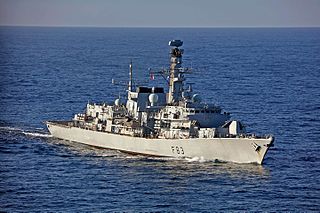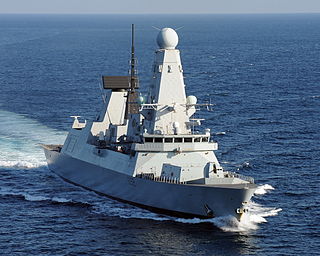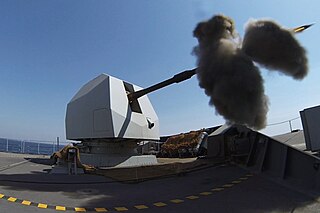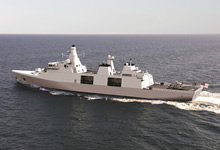
The Type 23 frigate or Duke class is a class of frigates built for the United Kingdom's Royal Navy. The ships are named after British Dukes, thus leading to the class being commonly known as the Duke class. The first Type 23, HMS Norfolk, was commissioned in 1989, and the sixteenth, HMS St Albans was commissioned in June 2002. They form the core of the Royal Navy's destroyer and frigate fleet and serve alongside the Type 45 destroyers. They were designed for anti-submarine warfare, but have been used for a range of uses. Ten Type 23 frigates remain in service with the Royal Navy, with three vessels having been sold to the Chilean Navy, one being retired in 2021, and two being retired in 2023.

The third and current HMS Argyll is a Type 23 Duke-class frigate. She is currently the oldest serving Type 23 frigate in the Royal Navy. Like all of her class she is named after a British dukedom, in this case that of Argyll. HMS Argyll was laid down in March 1987 by Yarrow Shipbuilders at Glasgow, and launched in 1989 by Lady Wendy Levene, sponsored by the Worshipful Company of Paviors. She was commissioned in May 1991. Argyll is currently based at HMNB Devonport.

The Type 45 destroyer, also known as the D or Daring class, is a class of six guided-missile destroyers built for the United Kingdom's Royal Navy in the early 21st century. The class is primarily designed for anti-aircraft and anti-missile warfare and is built around the PAAMS air-defence system using the SAMPSON Active electronically scanned array (AESA) and the S1850M long-range radars. The first three destroyers were assembled by BAE Systems Surface Fleet Solutions from partially prefabricated "blocks" built at different shipyards; the remaining three were built by BAE Systems Maritime – Naval Ships. The first ship in the Daring class, HMS Daring, was launched on 1 February 2006 and commissioned on 23 July 2009.

HMS St Albans is a Type 23 frigate of the Royal Navy. She is the sixth ship to bear the name and is the sixteenth and final ship in the 'Duke' class of frigates. She is based in Devonport, Plymouth.

The Principal Anti-Air Missile System (PAAMS) is a joint programme developed by France, Italy, and the United Kingdom for an integrated anti-aircraft warfare system. The prime contractor is EUROPAAMS, a joint venture between Eurosam (66%) and UKAMS (33%). In the United Kingdom, PAAMS has been given the designation Sea Viper.

Future planning of the Royal Navy's capabilities is set through periodic Defence Reviews carried out by the British Government. The Royal Navy's role in the 2020s, and beyond, is outlined in the 2021 defence white paper, which was published on 22 March 2021. The white paper is one component of the Integrated Review of Security, Defence, Development and Foreign Policy, titled as Global Britain in a Competitive Age which was published on 16 March 2021.

The Type 26 frigate, also known as City-class frigate, is a class of frigates being built for the United Kingdom's Royal Navy, with variants also being built for the Australian and Canadian navies. The programme, known as the Global Combat Ship, was launched by the British Ministry of Defence to partially replace the navy's thirteen Type 23 frigates, and for export. Its primary role is to conduct advanced anti-submarine warfare missions while supporting air defence and general purpose operations. The type is the first naval platform shared between Australia, Canada and the United Kingdom since the pre-Second World War Tribal-class destroyer.

The River class is a class of offshore patrol vessels built primarily for the Royal Navy of the United Kingdom. A total of nine were built for the Royal Navy (RN), four Batch 1 and five Batch 2. One Batch 1 (HMS Clyde), which was the Falklands guard ship, was decommissioned and transferred at the end of its lease to the Royal Bahrain Naval Force.

HMS Daring is the lead ship of the Type 45 or Daring-class air-defence destroyers built for the Royal Navy, and the seventh ship to hold that name. She was launched in 2006 on the Clyde and conducted contractor's sea trials during 2007 and 2008. She was handed over to the Royal Navy in December 2008, entered her base port of Portsmouth for the first time in January 2009 and was formally commissioned on 23 July 2009. As the lead ship of the first destroyer class built for the Royal Navy since the Type 42 in the 1970s, she has attracted significant media and public attention. Her name, crest and motto are a reference to the Roman youth Gaius Mucius Scaevola, famed for his bravery.

HMS Defender is the fifth of the Type 45 or Daring-class air-defence destroyers built for the Royal Navy. She is the eighth ship to bear the name. Construction of Defender began in 2006, and she was launched in 2009. The ship completed her first sea trials in October and November 2011, and was commissioned during March 2013.

HMS Duncan is the sixth and last of the Type 45 or Daring-class air-defence destroyers built for the Royal Navy and launched in 2010. Duncan is named after Adam Duncan, 1st Viscount Duncan, who defeated the Dutch fleet at the Battle of Camperdown on 11 October 1797. The destroyer has served in the Mediterranean, Black, and Caribbean Seas, and in 2019 was deployed to the Persian Gulf in response to increased tensions with Iran in the region.

The 4.5 inch Mark 8 is a British naval gun system which currently equips the Royal Navy's destroyers and frigates, and some British destroyers and frigates sold to other countries.
BAE Systems Maritime – Naval Ships is a wholly owned subsidiary company of BAE Systems, specialising in naval surface shipbuilding and combat systems integration. One of three divisions of BAE Systems Maritime, along with BAE Systems Submarines and BAE Systems Maritime – Maritime Services, it is the largest shipbuilding company in the United Kingdom, one of the largest shipbuilders in Europe, and one of the world's largest builders of complex warships.

The Type 31 frigate, also known as the Inspiration class, and formerly known as the Type 31e frigate or General Purpose Frigate (GPF), is a class of five frigates being built for the United Kingdom's Royal Navy, with variants also being built for the Indonesian and Polish navies. The Type 31 is intended to enter service in the 2020s alongside the eight submarine-hunting Type 26 frigate and will replace the five general-purpose Type 23 frigates. The Type 31 is part of the British government's "National Shipbuilding Strategy".

HMS Forth is a Batch 2 River-class offshore patrol vessel in active service with the Royal Navy. Named after the River Forth, she is the first Batch 2 River-class vessel to be built. She was commissioned into the Royal Navy on 13 April 2018, following a commissioning ceremony at her homeport HMNB Portsmouth. In January 2020 she replaced HMS Clyde as the Falkland Islands patrol ship.

HMS Trent is a Batch 2 River-class offshore patrol vessel, named after the River Trent. This is the sixth Royal Navy ship named Trent. She is the third Batch 2 River-class vessel to be commissioned and is forward deployed to Gibraltar for operations in the Mediterranean and Gulf of Guinea.

HMS Tamar is a Batch 2 River-class offshore patrol vessel of the Royal Navy. Named after the River Tamar in England, this is the seventh Royal Navy ship to be named Tamar. She is the fourth Batch 2 River-class vessel to be built and is forward deployed long-term to the Indo-Pacific region with her sister ship HMS Spey.

HMS Spey is a Batch 2 River-class offshore patrol vessel of the Royal Navy. Named after the River Spey in Scotland, she is the eighth Royal Navy ship to be named Spey and is the fifth Batch 2 River-class vessel to commission and is forward deployed long-term to the Indo-Pacific region with her sister ship HMS Tamar.
HMS Cardiff is the second Batch 1 Type 26 frigate to be built for the United Kingdom's Royal Navy. The first steel was cut on 14 August 2019. The Type 26 class will partially replace the navy's thirteen Type 23 frigates, and will be a multi-mission warship designed for anti-submarine warfare, air defence and general purpose operations.
HMS Belfast is a Type 26 frigate of the Royal Navy and the second vessel named after the Northern Ireland capital Belfast. In September 2017, her name was announced by the First Sea Lord. HM ships' names are selected by the Ships' Names and Badges Committee. HMS Belfast (C35) was renamed HMS Belfast (1938) by the Imperial War Museum to avoid confusion. She was ordered on 2 July 2017. The first steel was cut on HMS Belfast 29 June 2021 by HRH The Duke of Cambridge.



















